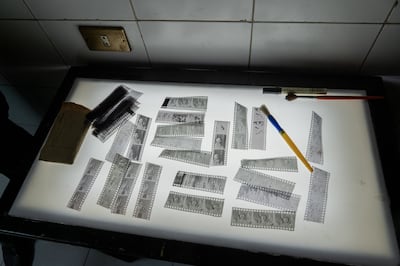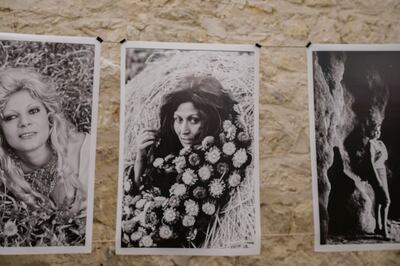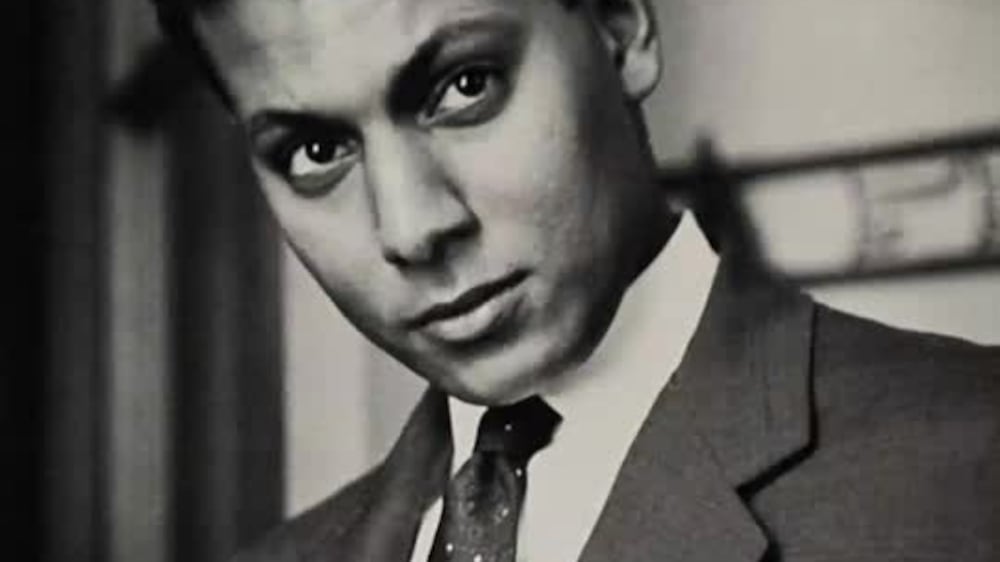Of all the photographers who have documented Egypt’s modern history, few were as prolific as Farouk Ibrahim.
His lens captured some of the country’s most memorable moments from the front lines of the 1973 Arab-Israel war to the inner workings of the presidency of Anwar Sadat and profiles of celebrated comedians and singers.
He spent 59 years photographing Egypt's most recognisable faces, from presidents Gamal Abdel Nasser, Sadat and Hosni Mubarak to singing legend Umm Kulthum, but by his own design remained largely out of the limelight. Instead, he preferred to “make stars out of his subjects than be a star himself”, his son, Karim, tells The National.

A retrospective of 140 photographs of Ibrahim’s work was visited by thousands last month, curated by Karim, one of his most ardent admirers. His son explains that he put together the exhibition, titled The Legend, to introduce contemporary audiences to his father and shine a light on his feverish documentation of Egypt’s modern history.
“Many people who visited did not really know who Farouk Ibrahim was. Some knew his more well-known photographs but didn’t know that he took them. But after going through the exhibit and seeing that same welcoming look that his subjects always had when he photographed them, visitors got the feeling that there must have been something special about this photographer who was welcomed by so many,” explains Karim, who followed in his father’s footsteps and is now a photojournalist at Akhbar El Youm, a state-affiliated weekly where his father worked in the 1960s.
Celebrity photographer

Among the personalities whose portraits hung in Downtown Cairo’s Access Gallery — for 10 days past their scheduled showing due to popular demand — was that of Umm Kulthum.
The singer, whose fans had grown accustomed to seeing in more sombre public settings, is captured in Ibrahim’s portrait with a girlish, easy smile, her signature handkerchief in one hand while the other is in a flourish by her side.
“He was truly amazing at communicating with his subjects and what I realised while archiving was how deep his process went,” explains Karim, who accompanied his father on multiple celebrity shoots as a child. "He would rigorously examine them, not just their clothes and appearance but also their personalities and the facets of themselves that their audiences were not used to seeing. I felt lucky to have seen him in action.”
Celebrities depicted in surprising settings were a perceptible theme of the exhibition, and among the dozens of square, black-and-white portraits that occupied the gallery’s largest viewing room, one was of acclaimed comedian Soheir El Bably wrapped in a wreath of flowers in a pose that summoned images of Brigitte Bardot’s “flower power” era.
El Bably was known for her loud, pugnacious brand of comedy in which she was not afraid to get messy, however, Ibrahim brought out a glamorous side of her that struck visitors to the exhibition.
“He had this uncanny ability to change the way he interacted with his subjects while shooting them that made them, in turn, accentuate different sides of their character," says Karim. "If we wanted them to be playful, he would joke around and if he wanted them to be more serious, he would discuss their jobs or careers with them."
A colour portrait of Nobel-winning Egyptian chemist Ahmed Zewail, whose presentation had always been that of a serious scientist, shows him smoking a hookah at a table in Khan El Khalili’s El Fishawy coffee shop in Cairo.
Ibrahim, rather masterfully, showed that there was more to Zewail than merely the studious academic.
Meeting Anwar Sadat

Aside from his celebrity portraiture, Ibrahim was also dedicated to journalism and documented some of the country’s most momentous political events, including the 1956 Arab-Israeli war, Sadat’s historic 1977 visit to Jerusalem, the first such visit by an Arab leader, and the signing two years later of the Egyptian-Israeli 1979 peace treaty.
He also photographed from the Egyptian front line during the 1973 Arab-Israeli war.
He was granted access to these events because of his relationship with Sadat, who had hired him as the presidency's official photographer after a rather unusual introduction.
“He heard that a German photographer had been hired to do a collection of portraits of the president and it made him crazy,” Karim recounts. "He could not contain himself, so he wrote Sadat a letter which he signed as ‘a child of the July revolution', requesting that Sadat let him take the photos first and if he didn’t like them, he could ask a foreign photographer to."
Sadat agreed to Ibrahim’s proposition, the president was reportedly taken by Ibrahim’s strong sense of initiative, though he held reservations about his photographic ability until the pair spent weeks together.
Throughout his relationship with Sadat, Ibrahim photographed him numerous times and accompanied him on a number of international visits including the visit to Camp David.
“He would travel for weeks on end and I remember I would go down to our local phone company to make international calls to speak to him. Even in those brief conversations, we would talk about photography.”
Son gets to know his father
Though they often spent months apart because of his father’s frequent travel, Karim has always felt a deep affinity with his father, a relationship that was very much rooted in the pair’s obsession with photography.
“He was a photographer 24 hours a day. He shot every day and thought about photography most of the time. So in order to have a relationship with him, I had to keep in mind that I was dealing with a photographer and that I would lose his attention if our conversations didn’t return to photography.”
Ibrahim died in 2011 amid the Arab Spring uprising that ousted former president Hosni Mubarak. His last batch of photos are of the revolution. One of protestors in Tahrir Square is the final photo he ever took.
It was also the last photo that vistors of the exhibit saw before leaving the gallery.
The first photo he ever took was of the 1952 Free Officers uprising that brought Gamal Abdel Nasser to power. Nasser is the centrepiece of the photo, which was the opener of the exhibit.
Karim recalls becoming disillusioned with photography after his father's death and despite working with him closely to put the archive together from 2008 until 2011, he left it untouched until last year when he began curating the exhibition.
“When he died, what bothered me the most for a while was that I couldn’t find anyone else who was as fun to be around. I felt I had lost the best person to go out with and play around with — aside from the fact that he was my father.”
As he sifted through the archive, he began to realise how much time he had spent apart from his father and how much of his life he had not been around to see.
He was also delighted to find secret messages his father hid in the film rolls he left behind in the archive.
"He left white dots on the shots that he liked or that he thought were remarkable. He would leave a green dot on any photos that he thought were the best in that film roll," Karim says, “I got to know him on a much deeper level and I have not even come close to going through the entire archive yet. I even found a photo he took on the day I was born, which I didn’t know about.”
While trying to come up with a theme for the exhibition, Karim was stumped until “I realised it had to be him, he had to be the focus. He had spent his whole life behind the camera and many didn’t really know him.”
After the resounding success of The Legend, Karim is planning another retrospective of his father’s work and with 59 years' worth of photos and film rolls, he does not anticipate that it will be too difficult.







